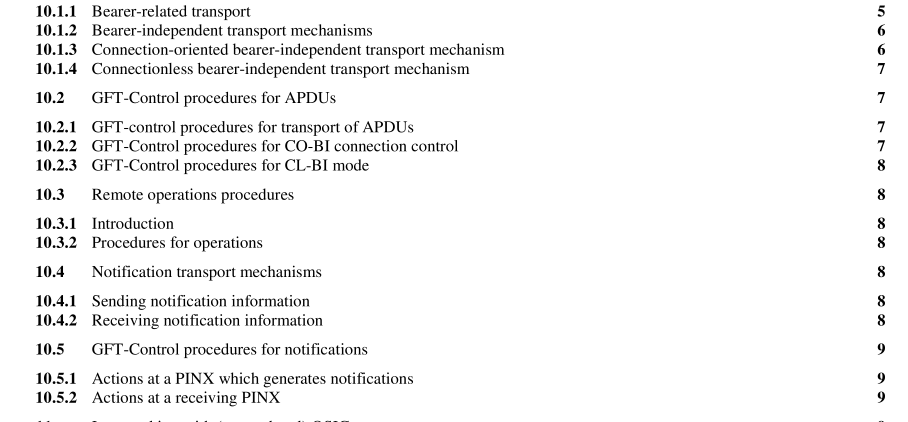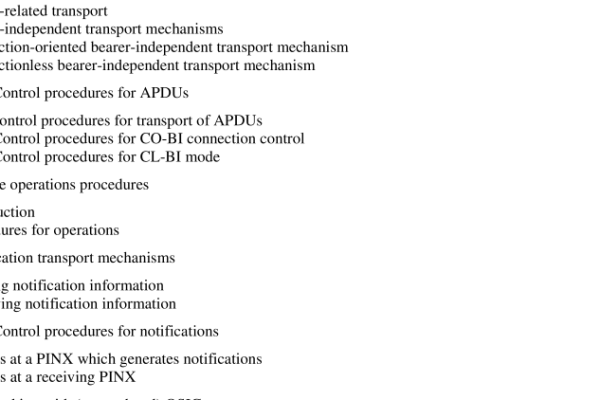ISO IEC 19058:2001 pdf download – Information technology — Telecommunications and information exchange between systems — Broadband Private Integrated Services Network — Inter-exchange signalling protocol — Generic functional protocol.
1 Scope This International Standard specifies the functional protocol for the support ofsupplementary services and additional basic call capabilities at the Q-reference point. The Q-reference point exists between Private Integrated services Network eXchanges (PINX) connected together within a Private Integrated Services Network (PISN) and is defined in ISO/IEC 11579-1. The generic functional protocol is part ofthe B-QSIG signalling system. The procedures specified in this International Standard can be used in association with a bearer connection (bearer-related) or outside the context of any bearer connection (bearer-independent).The application of this International Standard to individual additional basic call capabilities and supplementary services is outside the scope of this International Standard and should be defined in those standards or proprietary specifications that specify the individual capabilities. All conformance to this International Standard is based on the external behaviour at the interface at the Q-reference point, i.e. on the generation ofthe correct message structure and in the proper sequence as specified in this International Standard. The generic functional protocol is based on ATM Forum specification AF-CS-0102.000, which itself is based on the DSS2 generic functional protocol specified in ITU-T Rec. Q.2932.1 but extended to allow non-local information exchange as well as local information exchange. This International Standard is applicable to PINXs supporting additional basic call capabilities and/or supplementary services requiring the functional protocol for signalling at the Q-reference point. 2 Conformance In order to conform to this International Standard, a PINX shall satisfy the requirements identified in the Protocol Implementation Conformance Statement (PICS) proforma in section 30 ofAF-CS-0102.000. 3 Normative references The following normative documents contain provisions which, through reference in this text, constitute provisions of this International Standard. For dated references, subsequent amendments to, or revisions of, any of these publications do not apply. However, parties to agreements based on this International Standard are encouraged to investigate the possibility of applying the most recent editions of the normative documents indicated below. For undated references, the latest edition of the normative document referred to applies. Members ofISO and IEC maintain registers ofcurrently valid International Standards.
4 Terms and definitions For the purposes of this International Standard, the terms and definitions given in section 26.3 of AF-CS-0102.000 and the following apply. 4.1 Gateway PINX : The definition in ISO/IEC 13247 shall apply. Dependent on the capabilities of the signalling system being interworked by the gateway PINX, it can act as a Transit or an End PINX in the context of the supplementary services APDUs. That is, it can either transport the APDUs unchanged to or from the other signalling system, perhaps embedded in some other protocol unit, or process the APDUs and perform an interworking function of the information flows and encoding ofthe Supplementary service concerned. 4.2 Inter-PINX link (IPL) : The definition in ISO/IEC 13247 shall apply. 4.3 Preceding side : In the context of a call/connection or a CO-BI connection using an IPL, the side that initiates call/connection or CO-BI connection establishment over that IPL (see figure 1 in ISO/IEC 13247). 4.4 Private Integrated services Network eXchange (PINX) : As specified in ISO/IEC 11579-1.
ISO IEC 19058:2001 pdf download – Information technology — Telecommunications and information exchange between systems — Broadband Private Integrated Services Network — Inter-exchange signalling protocol — Generic functional protocol






